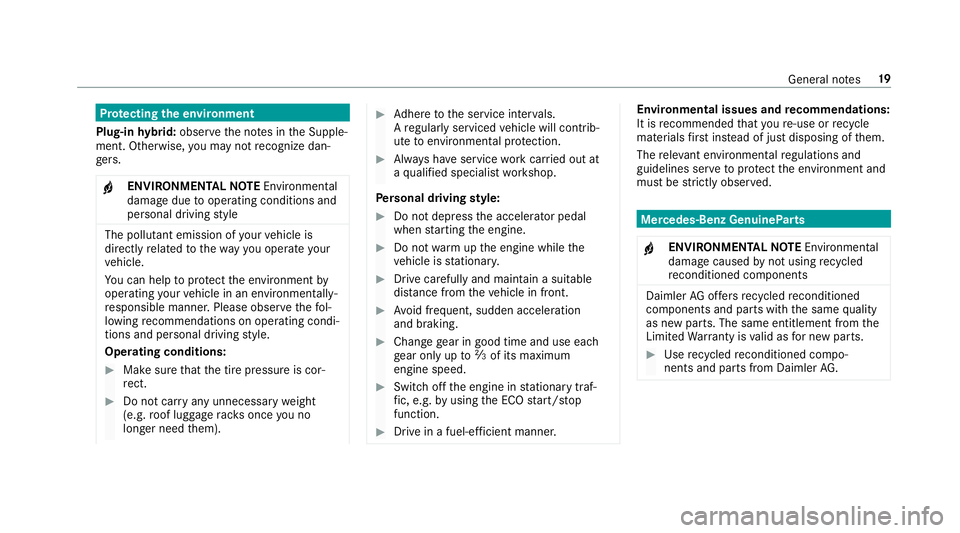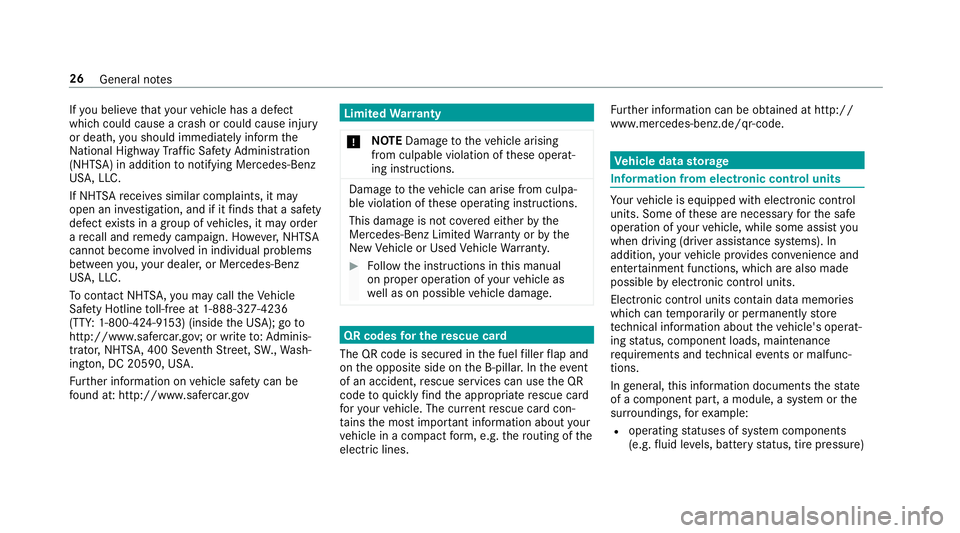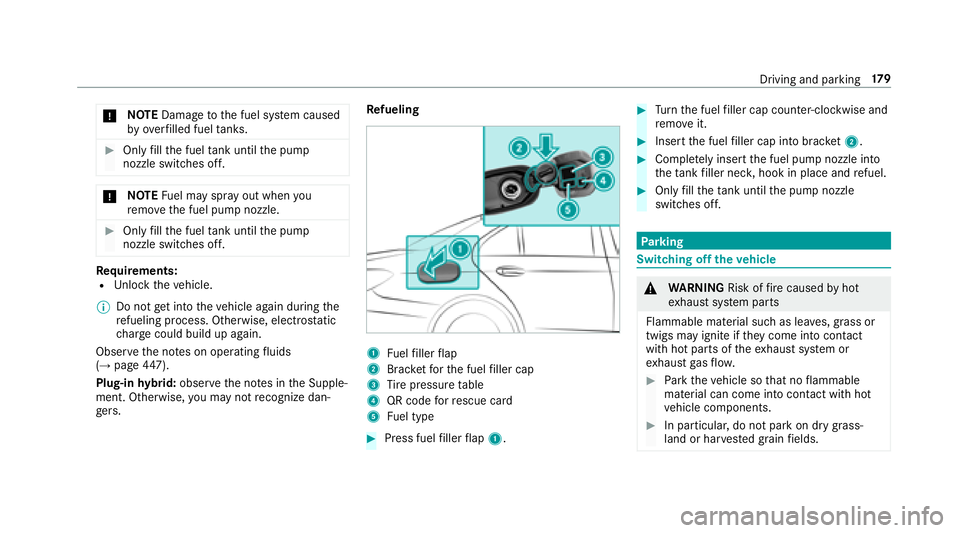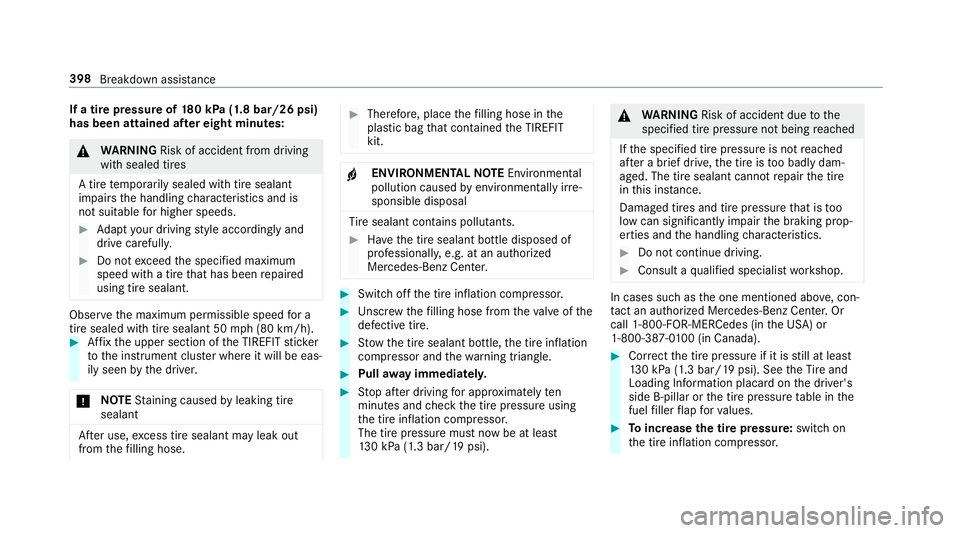2018 MERCEDES-BENZ S-CLASS SEDAN fuel pressure
[x] Cancel search: fuel pressurePage 5 of 562

Function of the infra redre flective wind‐
shield ......................................................... .155
Climate control ......................................... 157
Overview of climate contro l systems ......... .157
Operating the climate control sy stem ......... 158
Drivin gand pa rking ................................. 165
Driving ........................................................ 165
DY NA MIC SELECT switch ............................1 72
Au tomatic transmission .............................. 173
Re fueling ..................................................... 177
Pa rking ...................................................... .179
Driving and driving saf etysy stems ............ .188
Instrument Display and on-board
comp uter .................................................. 244
Instrument Display overview ...................... .244
Overview of the buttons on thesteering
wheel ......................................................... .245
Operating the on-board computer .............. 245
Overview of displa ysinthe multifunction
display ........................................................ 247 Ad
justing the instrument lighting ............... .247
Menus and submenus ................................. 248
Head-up Display ......................................... 254
Vo ice Control Sy stem .............................. 256
Operating saf ety........................................ .256
Operation ................................................... 256
Using theVo ice Cont rol Sy stem ef fec‐
tively ........................................................... 258
Essential voice commands ........................ .259
Multimedia sy stem .................................. 269
Overview and operation .............................. 269
Sy stem settings .......................................... 277
ENERGIZING comfort .................................. 289
Na vigation ................................................... 291
Te lephone .................................................. .315
Online and Internet functions ..................... 330
Media ......................................................... 337
Ra dio .......................................................... 350
Sound .........................................................3 57
Re ar Seat En tertainment Sy stem ............... .360
Maintenance and care .............................377
ASS YST PLUS service inter val display ........ .377
Engine compartment .................................. 378
Cleaning and care ...................................... .385
Breakdown assist ance............................ 393
Emergency ..................................................3 93
Flat tire ....................................................... 393
Battery (vehicle) ......................................... 399
To w starting or towing away ....................... 404
Electrical fuses ............................................ 410
Wheels and tires ....................................... 413
Noise or unusual handling characteristics .. .413
Checking wheels and tires regularly ............ 413
No tes on snow chains ................................ .414
Ti re pressure ...............................................4 14
Loading theve hicle .................................... 420
Ti re labeling ................................................ 425
Definition of term sfo r tires and loading ..... 431
Changing a wheel ....................................... 433
Contents 3
Page 11 of 562

1Speedom eter →
244
2 AIR BODY CONTROL malfunctioning →
511
3 #! Turn signal light →
144
4 Multifunction display →
247
5 Tach ome ter →
244
6 å ESP
®OFF →
503
÷ ESP
®→
503
7 K High beam →
144
L Low beam →
143
T Parking lights →
143
8 ? Coolant too hot/cold →
513
9 Coolant temp erature gauge →
244
A · Distance warning →
511
B Ð Steering assis tance malfunction →
512
C # Electrical malfunction →
513
D Brakes (red) →
503
$USA only
J Canada only
E ü Seat belt is not fastened →
510
F Fuel le vel indicator
G 8 Fuelreser vewith fuel filler flap location
indicator →
513
H R Rear fog light →
144
I 6 Restra int sy stem
J % Indicator lamp has no function
K ; Check Engine →
513
L J Brakes (yell ow) →
503
M Electric parking brake applied (red) →
503
F USA only
! Canada only
N h Tire pressure monitoring sy stem →
517
O ! ABS malfunction →
503
P ! Electric pa rking brake (yellow) →
503
Ataglance – Warning and indicator lamps 9
Page 19 of 562

Whattodo in theeve nt of an accident
1 QR code for accessing there scue card →
26
2 Safetyve sts →
393
3 Button forth e SOS emer gency call sy stem and
Ro adside Assis tance →
328
4 Checking and topping up operating fluids →
447
5 Tow- starting and towing away →
405
6 Flat tire →
3937Starting assis tance →
401
8 Haza rdwa rning lights →
145
9 Fuelfiller flap with instruction labels for tire
pressure , fuel type and QR codes for accessing
th ere scue card →
177
A Tow- starting and towing away →
405
B TIREFIT kit →
395
Ataglance – Emer gencies and breakdowns 17
Page 21 of 562

Protecting the environment
Plug-in hybrid: obser vethe no tes in the Supple‐
ment. Otherwise, you may not recognize dan‐
ge rs.
+ENVIRONMENTAL NOTEEnvironmental
damage duetooperating conditions and
personal driving style
The pollutant emission of your vehicle is
directly related tothewa yyo u operate your
ve hicle.
Yo u can help toprotect the environment by
operating your vehicle in an environmentally-
re sponsible manner. Please obser vethefo l‐
lowing recommendations on ope rating condi‐
tions and pe rsonal driving style.
Operating conditions:
#Make sure that the tire pressure is cor‐
re ct.
#Do not car ryany unnecessary weight
(e.g. roof luggage rack s once you no
longe r need them).
#Ad here tothe service inter vals.
A regularly serviced vehicle will contri b‐
ute toenvironmen tal pr otection.
#Alw ays ha veservice workcar ried out at
a qu alified specialist workshop.
Pe rsonal driving style:
#Do not depress the accelera tor pedal
when starting the engine.
#Do not warm upthe engine while the
ve hicle is stationar y.
#Drive carefully and maintain a suitable
dist ance from theve hicle in front.
#Av oid frequent, sudden acceleration
and braking.
#Change gear in good time and use each
ge ar only uptoÔ of its maximum
engine speed.
#Switch off the engine in stationary traf‐
fi c, e.g. byusing the ECO start/ stop
function.
#Drive in a fuel-ef ficient manne r.
Environmental issues and recommendations:
It is recommended that youre -use or recycle
materials firs t ins tead of just disposing of them.
The releva nt environmental regulations and
guidelines ser vetoprotect the environment and
must be strictly obser ved.
Mercedes-Benz GenuineParts
+ENVIRONMEN TALNO TEEnvironmental
damage causedbynot using recycled
re conditioned components
Daimler AGoffers recycled reconditioned
components and part s withthe same quality
as new parts. The same entitlement from the
Limited Warranty is valid as for new parts.
#Use recycled reconditioned compo‐
nents and part s from Daimler AG.
Gene ral no tes 19
Page 28 of 562

Ifyo ubelie vethat your vehicle has a defect
which could cause a crash or could cause injury
or death, you should immediately inform the
Na tional Highw ayTraf fic Saf etyAd ministration
(NHT SA) in addition tonotifying Mercedes-Benz
US A,LLC.
If NHT SAreceive s similar complaints, it may
open an in vestigation, and if it finds that a saf ety
defect exists in a groupof vehicles, it may order
a re call and remedy campaign. Ho wever,NHT SA
cannot become in volved in individual problems
between you, your dealer, or Mercedes-Benz
US A,LLC.
To contact NHT SA,yo u may call theVe hicle
Saf etyHotlin eto ll-f ree at 1-888-327-4236
(TT Y:1-800-424-9 153) (inside the USA); go to
http://www.safercar.gov; or write to:Ad minis‐
trator, NHT SA, 400 Se venth Street,SW .,Wa sh‐
ington, DC 20590, US A.
Fu rther information on vehicle saf etycan be
fo und at: http:/ /www.safercar.g ovLimitedWarranty
* NO
TEDama getotheve hicle arising
from culpable violation of these operat‐
ing instructions.
Damage totheve hicle can arise from culpa‐
ble violation of these operating instructions.
This damage is not co vered either bythe
Mercedes-Benz Limited Warranty or bythe
New Vehicle or Used Vehicle Warrant y.
#Follow the instructions in this manual
on proper operation of your vehicle as
we ll as on possible vehicle damage.
QR codes for the rescue card
The QR code is secured in the fuel filler flap and
on the opposite side on the B-pillar. In theeve nt
of an accident, rescue services can use the QR
code toquickly find the appropriate rescue card
fo ryo ur vehicle. The cur rent rescue card con‐
ta ins the most impor tant information about your
ve hicle in a compact form , e.g. thero uting of the
electric lines. Fu
rther information can be obtained at http://
www.mercedes-benz.de/qr-code.
Ve hicle data storage
Information from electronic control units
Yo ur vehicle is equipped with electronic contro l
units. Some of these are necessary forth e safe
operation of your vehicle, while some assist you
when driving (driver assis tance sy stems). In
addition, your vehicle pr ovides con venience and
enter tainment functions, which are also made
possible byelectronic control units.
Elect ronic control units contain da tamemories
which can temp orarily or permanently store
te ch nical information about theve hicle's operat‐
ing status, component loads, mainte nance
re qu irements and tech nical events or malfunc‐
tions.
In general, this information documents thest ate
of a component part, a module, a sy stem or the
sur roundings, forex ample:
Roperating statuses of sy stem components
(e.g. fluid le vels, battery status, tire pressure)
26
General no tes
Page 179 of 562

Using kickdown
Mercedes-AMGvehicles: be sure toobser ve
th e no tes in the Supplement. Otherwise, you
may not recognize dangers.
#Maximum acceleration: depress the accel‐
erator pedal be yond the pressure point.
During kickdown, you cannot shift gears using
th esteering wheel paddle shif ters. The au to‐
matic transmission shifts up tothe next gear
when the maximum engine speed is reached to
pr otect the engine from overrev ving.
#Ease off the accelera tor pedal once the
desired speed is reached.
Glide mode function
Plug-in hybrid: be sure toobser vethe no tes in
th e Supplement. Otherwise, you may not recog‐
nize dangers.
Mercedes -AMG vehicles: be sure toobser ve
th e no tes in the Supplement. Otherwise, you
may not recognize dangers. Wi
th an anticipatory driving style, glide mode
helps youto reduce fuel consum ption.
Glide mode is characterized bythefo llowing:
RThe combustion engine is disconnected from
th e driv etra in and theve hicle continues to
ro ll in neut ral.
RThe transmission position his displa yed in
green in the multifunction displa y.
Glide mode is activated if thefo llowing condi‐
tions are me t:
RDrive program Eis selected.
RThe speed is wi thin a suitable range.
RThe cours e ofthero ad is suitable, e.g. no
st eep uphill or downhill gradients or tight
bends.
RYo udo not depress the accelera tor or brake
pedal.
% Glide mode can also be activated if you ha ve
selected the "Eco" setting forth e drive
(engine management) when in drive program
I. Glide mode is deactivated again if one of
the
conditions is no longer met.
Ve hicles with Active Di stance Assistant
DI STRO NIC:When Active Dis tance Assist ant
DI STRO NIC is active, theglide mode function is
re stricted.
Re fueling
Refueling theve hicle
&
WARNING Risk offire and explosion
caused byfuel
Fu els are highly inflammable.
#You must avoidfire , open flames, creat‐
ing spar ksand smoking.
#Before refueling, switch off the engine
and, if ins talled in your vehicle, thest a‐
tionary heater.
& WARNING Risk of injury from fuel
Fu els are poisonous and harmful to your
health
Driving and parking 17
7
Page 181 of 562

*NO
TEDama getothe fuel sy stem caused
by ove rfilled fuel tanks.
#Only fill th e fuel tank until the pump
nozzle switches off.
* NO
TEFuel may spr ayout when you
re mo vethe fuel pump nozzle.
#Only fill th e fuel tank until the pump
nozzle switches off.
Re quirements:RUn lock theve hicle.
% Do not get into theve hicle again during the
re fueling process. Otherwise, electros tatic
ch arge could build up again.
Obser vethe no tes on operating fluids
(
→page 447).
Plug-in hybrid: obser vethe no tes in the Supple‐
ment. Otherwise, you may not recognize dan‐
ge rs. Re
fueling1Fuelfiller flap
2Brac ketfo rth e fuel filler cap
3Ti re pressure table
4QR code forre scue card
5Fu el type
#Press fuel filler flap 1.
#Turn the fuel filler cap coun ter-clockwise and
re mo veit.
#Insert the fuel filler cap into brac ket2.
#Co mp lete ly inse rtthe fuel pump nozzle into
th eta nk filler nec k,hook in place and refuel.
#Only fill th eta nk until the pump nozzle
switches off.
Pa rking
Switching off theve hicle
&
WARNING Risk offire caused byhot
ex haust sy stem parts
Flammable material such as lea ves, grass or
twigs may ignite if they come into contact
wi th hot parts of theex haust sy stem or
ex haust gasflow .
#Park theve hicle so that no flammable
material can come into con tact wi thhot
ve hicle components.
#In particular, do not park on dry grass‐
land or har vested grain fields.
Driving and parking 17
9
Page 400 of 562

If a tire pressureof180 kPa (1.8 bar/26 psi)
has been attained af ter eight minutes:
&
WARNING Risk of accident from driving
wi th sealed tires
A tire temp orarily sealed with tire sealant
impairs the handling characteristics and is
not suitable for higher speeds.
#Ad apt your drivin gst yle according lyand
drive carefull y.
#Do notexceed the specified maximum
speed with a tire that has been repaired
using tire sealant.
Obser vethe maximum permissible speed for a
tire sealed with tire sealant 50 mph(8 0 km/h).
#Af fix th e upper section of the TIREFIT sticke r
to the instrument clus ter where it will be eas‐
ily seen bythe driver.
* NO
TEStaining caused byleaking tire
sealant
Af ter use, excess tire sealant may leak out
from thefilling hose.
#Therefore, place thefilling hose in the
plastic bag that con tained the TIREFIT
kit.
+ENVIRONMEN TALNO TEEnvironmental
pollution caused byenvironmen tally ir re‐
sponsible disposal
Ti re sealant contains polluta nts.
#Have the tire sealant bottle disposed of
professionall y,e.g. at an authorized
Mercedes-Benz Center.
#Switch off the tire inflation compressor.
#Un scr ew thefilling hose from theva lve of the
defective tire.
#St ow th e tire sealant bottle, the tire inflation
compressor and thewa rning triangle.
#Pull away immediatel y.
#Stop af ter driving for app roxima tely ten
minutes and check the tire pressure using
th e tire inflation compressor.
The tire pressure must now be at least
13 0 kPa (1.3 bar/19 psi).
&
WARNING Risk of accident due tothe
specified tire pressure not being reached
If th e specified tire pressure is not reached
af te r a brief drive, the tire is too badly dam‐
aged. The tire sealant cannot repair the tire
in this ins tance.
Dama ged tires and tire pressure that is too
low can significantly impair the braking prop‐
erties and the handling characteristics.
#Do not continue driving.
#Consult a qualified specialist workshop.
In cases such as the one mentioned abo ve, con‐
ta ct an au thorized Mercedes-Benz Center. Or
call 1-800-FOR-MERC edes (inthe USA) or
1-800-387-0 100 (in Canada).
#Cor rect the tire pressure if it is still at least
13 0 kPa (1.3 bar/19 psi). See theTire and
Loading Info rmation placard on the driver's
side B‑pillar or the tire pressure table in the
fuel filler flap forva lues.
#To increase the tire pressure: switchon
th e tire inflation compressor.
398
Breakdown assis tance